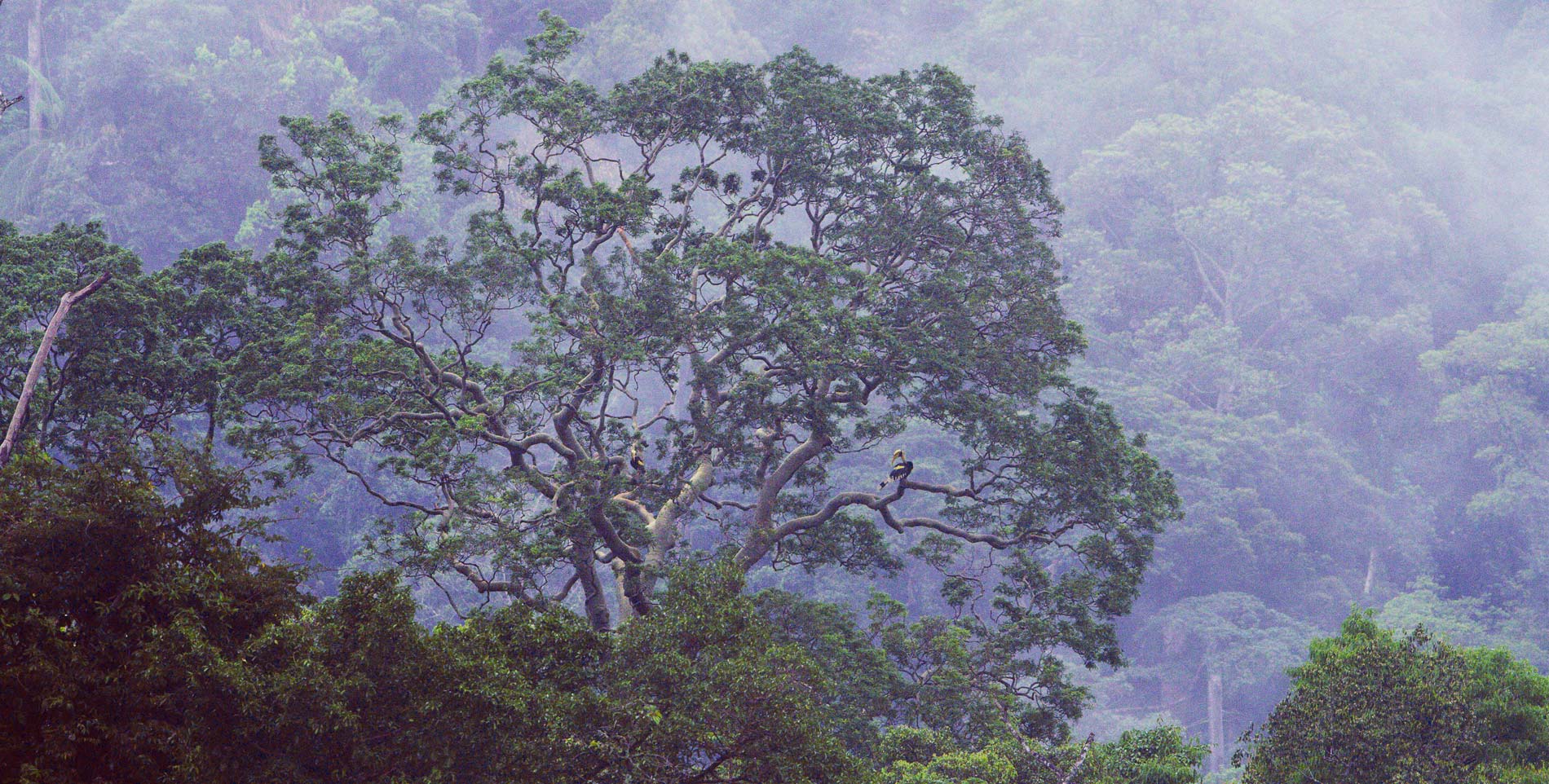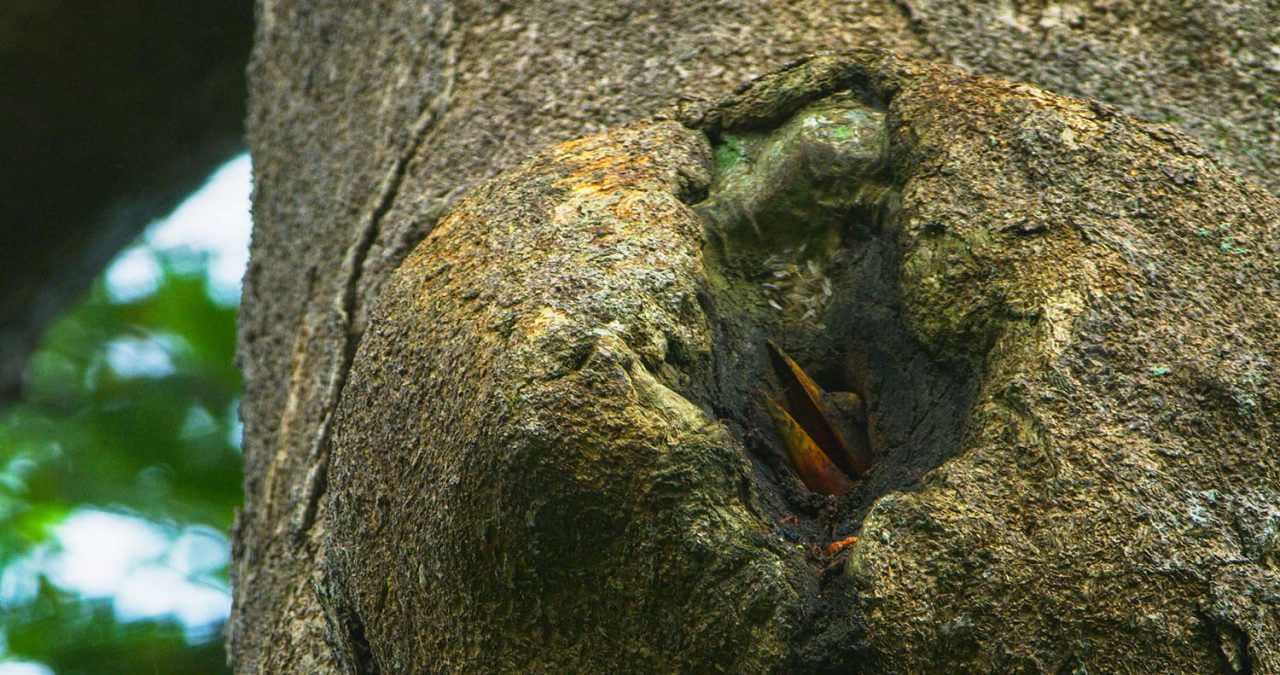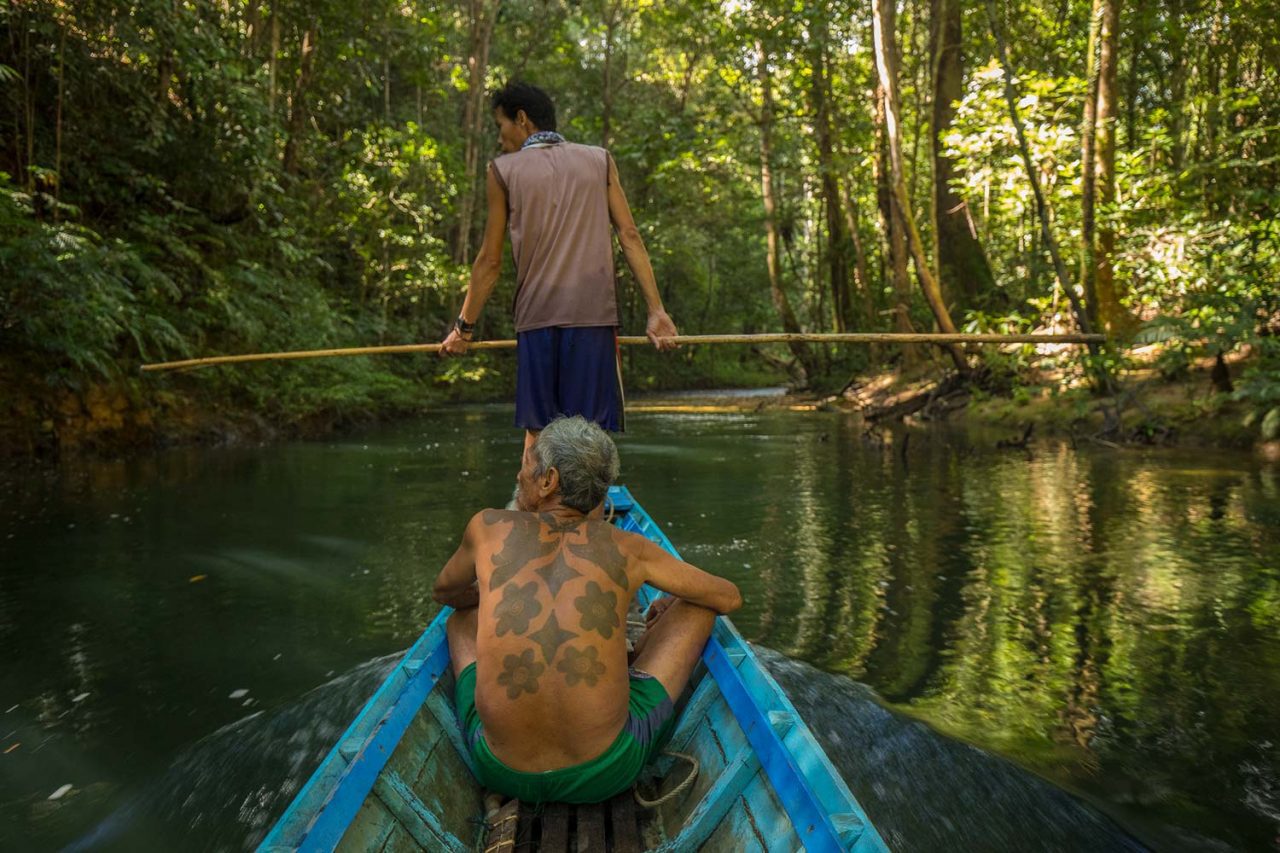The Helmeted Hornbill Is a Living Treasure—and That’s a Problem
Story, photos, and video by Tim Laman
A male Helmeted Hornbill in Budo-Sungai Padi National Park, Thailand. December 19, 2018From the Winter 2019 issue of Living Bird magazine. Subscribe now.
This project was made possible with support from the Robert F. Schumann Foundation, a charitable trust dedicated to improving the quality of life of both humans and animals by supporting environmental, educational, arts, and cultural organizations and agencies.
The photography and videography were produced in collaboration with National Geographic Magazine and are part of a multimedia effort to raise international awareness about the plight of the Helmeted Hornbill.
Alive or dead? Living free, or a decoration in someone’s home? What is to be the fate of the Helmeted Hornbill?
I was forced to confront this question in the past year, as I mounted expeditions to document this unique bird in the wild—before it disappears.
I’ve been fascinated by hornbills since the first year I spent living in the rainforests of Borneo, now 30 years ago. I’ve photographed many hornbill species in many forests of Southeast Asia over the last few decades, but the Helmeted Hornbill remained the most elusive. They live in the most remote tracts of old-growth forests, so they’ve always been hard to find. And I never had great success trying to photograph them.
Then in 2015 the International Union for Conservation of Nature made an emergency declaration, elevating the Helmeted Hornbill’s status to “critically endangered”—the last category before “extinct.” The poaching of hornbills for their elaborate, ivory-like rostrum (called a casque) had escalated to a rate that could mean extinction within a decade.


Hornbills are a favorite photographic subject for Laman, but few are as difficult to locate as the Helmeted. This Great Hornbill in Thailand’s Hala-Bala Wildlife Sanctuary was relatively easy by comparison. 

Rhinoceros Hornbills are also easier to find and occur in less remote areas of rainforest than the Helmeted Hornbill.
It was now or never to document the Helmeted Hornbill in the wild. So in 2017 and 2018, I made a series of expeditions to tell the story of this majestic, ornamented bird before it was too late. My journeys took me deep into some of the most pristine remaining forests in southeast Asia. I built blinds near fig trees and waited for hornbills to come and feed—which yielded excellent luck with Rhinoceros Hornbills and Great Hornbills, two related speces that are not valuable for the black market in ornamental carving, because their casques are hollow.
But the Helmeted Hornbill has a solid keratin casque, like a softer version of elephant ivory. That solid casque is targeted by poachers, and it has been the reason for the species’s demise. If Helmeted Hornbills had ever foraged among these fig trees, they were gone now. Or perhaps they were hiding. Helmeted Hornbills are notoriously reclusive, keenly alert to humans in their forest. Their scientific name attests to their cunning: Buceros vigil—the vigilant hornbill.


Old Growth Denizen
In all the world, Helmeted Hornbills are only found on the islands of Borneo and Sumatra, and up the Malay peninsula into southern Thailand. Within this range, they are limited to intact, old-growth rainforest where the trees grow large enough to accommodate hornbill nests. Because of deforestation in this region, Helmeted Hornbill habitat shrank significantly in recent decades.
I journeyed to Thailand’s Budo-Sungai Padi National Park, one of the hornbill’s few remaining strongholds, to team up with researcher Pilai Poonswad of the Thailand Hornbill Project. She and her team have been studying Helmeted Hornbills in Budo-Sungai Padi for over two decades. With their guidance, I located a tree along a flight path for a male Helmeted Hornbill flying to and from his nest. From my blind 100 feet up, secreted away in the treetops, I was able to wait out the coming of dawn for the moment when the male flew past, capturing an image of a mature male Helmeted Hornbill winging out over the canopy.


Dedicated Mates


In March of 2018, I got an exciting tip from an Indonesian conservation group working in West Kalimantan province. Indonesian scientists were surveying bird populations in remote forests on the island of Borneo, and they had discovered a pair of Helmeted Hornbills making regular visits to a potential nest cavity in a huge dipterocarp tree. I was already in Indonesia on another photo assignment, so getting to the site involved only a short plane flight, a six-hour drive, an hour on a motorbike in the dark, and then a three-hour hike into the mountains after sleeping on a floor in a village.
On the very afternoon I arrived, I was rewarded by seeing first the male, and then the female, fly to the nest tree and land by the cavity. The female spent 15 minutes putting her head into the opening, and knocking at it with her bill, perhaps to enlarge it slightly or make other home improvements. After I left, the hornbill pair commenced nesting.
A female Helmeted Hornbill pledges her life when entering the nest. After mating, she enters the nest cavity and lays her egg (usually just one). She then seals up the entrance to the nest, using a plaster she makes from regurgitated fruit pulp and feces. The only opening left into the nest is just big enough for the male to pass her food. Then, for the next five months—the entire incubation and nestling period until fledging—the female remains inside, sequestered from the world and entirely dependent on the male for food.


The female Helmeted Hornbill waits for food deliveries from the male with her beak protruding from inside the sealed nest hole. 

The deliveries come about three to five times per day. 

When the male arrives, he regurgitates figs gathered from his foraging trips. 

After regurgitating the figs, the male reaches inside the nest hole to pass the figs into the female’s beak. The male may transfer as many as 30 small figs in a delivery.
The Feeding Ritual
Back in Thailand’s Budo-Sungai Padi National Park, researcher Pilai Poonswad’s team had located two active nests and invited me to photograph them. Their unique conservation program has successfully turned former poachers from the surrounding villages into nest guardians who search out Helmeted Hornbill nests and are paid to monitor them throughout the breeding season. Here I had the unique opportunity, while hidden in blinds, to photograph the intimate interaction between mated hornbills as the male made his daily food deliveries.
At one of the nests, I had an angle to see the female’s bill protruding from the nest opening, accepting the day’s rations—mostly wild figs, but also the occasional stick insect. Males are also known to bring lizards, snakes, and other small animals to supplement the largely fruit-based diet for the growing chick.
Hornbills are very particular about the tree cavities they choose to nest in, because the floor of the cavity needs to be just the right depth so that the female can sit and still reach food passed in by the male, as well as take care of nest hygiene by tossing out waste.
The fortress of a hornbill nest sealed inside a tree cavity provides protection from predators such as monkeys and monitor lizards, which makes their extraordinary breeding strategy of investing so much time and energy into raising a single chick pay off. Helmeted Hornbills have a very high breeding success rate.


Conservationist Yoki Hadiprakarsa investigates a stockpile of confiscated Helmeted Hornbill casques in Jakarta. Smugglers move hornbill casques through the black market for sale as ornaments and artwork. 

Illegal hornbill casque bracelet and artwork for sale in a shop in Shanghai, China, in 2017. 

Hornbill casque carvings confiscated by U.S. customs. 

Illegal logging in Thailand’s Budo-Sungai Padi National Park threatens Helmeted Hornbill nesting habitat.
An Unsustainable Toll
Helmeted Hornbills, like many other species reliant on old-growth habitat, face the long-term problem of a dwindling supply of forest left to live in. As human populations grow, forest cover continues to decrease.
Even in protected national parks, illegal logging sometimes removes large old trees, and thus hornbill nest sites. But the most immediate threat to the future of Helmeted Hornbills is hunting for the illegal trade in hornbill products. When Indonesian conservationist Yoki Hadiprakarsa investigated hornbill poaching for the black market, he discovered that thousands of dead hornbills were being trafficked in 2014 and 2015 in West Kalimantan province alone. His findings shocked the world. When I traveled with him to a regional office of Indonesia’s Department of Nature Conservation in 2018, I saw the carnage firsthand—200 severed hornbill casques confiscated from smugglers, stacked and piled up on a table. These beaks certainly represented more hornbills than any one human would see in the wild in a lifetime. And these were just the ones that the smugglers failed to export. (BirdLife International has more on the cultural history of hornbill carvings.)


Tribal elder Abai Janggot in Indonesia has pledged to protect the Helmeted Hornbill. 

Janggot travels upriver in the Sungai Utik forest of Indonesia. 

The remote Sungai Utik forest of Indonesia.
Hope for Hornbills Among the People


After our depressing visit to the stockpile of dead hornbills, we got a boost of hope by making a visit to the Iban tribal village of Sungai Utik, deep in the interior of West Kalimantan. This is a tribe that has fiercely defended their ancestral lands against encroachment by logging and oil palm companies and managed to secure legal title to their lands.
We traveled upriver with Abai Janggot, an Iban elder who led the land rights fight for his tribe, and who had great hopes for the potential of tourists coming to see Helmeted Hornbills in their forest. Yoki Hadiprakarsa and his Indonesian hornbill conservation group Rangkong Indonesia are working to train the tribal villagers to be birding guides. We traveled up the river from their longhouse for a couple hours into their beautiful forest, landing at a simple guesthouse where we spent the night.
In the morning, we hiked up a ridge toward a fruiting fig tree, and on the way we heard that unmistakable call of the Helmeted Hornbill—the building crescendo of loud “hoots” ending in a cascade of maniacal laughter. The calls came from multiple directions, meaning there were several birds in the area.
Looking around at the excited faces near me—Yoki and a couple young Indonesian conservationists from his team, and also the Iban landowners—I had hope for this species under siege, hope in these people looking after their forest with a vision for a future livelihood in harmony with the Helmeted Hornbill.


Promise for the Future
I believe there will still be Helmeted Hornbills flying through wild forests in the next century. But if that is to be so, these birds face a critical period dead ahead.
Right now, there are still small numbers of breeding pairs in the best-protected, most remote forests in Indonesia and Thailand. Encouragingly, there are people who care greatly about the future of this species and are trying to care for these forests.
Some of them, like the Iban landowners of Sungai Utik forest, control their own land where the Helmeted Hornbills still live and are committed to protecting them. But in the long term, these small refuges will not be enough to safeguard viable populations. They will have to be the source for the species to breed, prosper, and spread more widely again into the areas where hornbills have been extirpated.
For this to happen, the poaching needs to stop. And for that to happen, the demand for the hornbill casques must be eliminated. This will take time, a lot of education, and perhaps a cultural shift in China, where most hornbill casques reach market.
Encouragingly, as Chinese conservationist Xu Ling told me, “The younger generation gets it. They don’t want to buy wildlife products any more.”
I hope that she’s right.
Tim Laman is a research associate in ornithology at Harvard University, contributing photographer for National Geographic Magazine, and cofounder with Edwin Scholes of the Cornell Lab of Ornithology’s Birds-of-Paradise Project. See more of his photography in this National Geographic article about Helmeted Hornbills.
The photography/videography for this article was produced in collaboration with National Geographic Magazine and is part of a multimedia effort to raise international awareness about the plight of the Helmeted Hornbill.


All About Birds is a free resource
Available for everyone,
funded by donors like you






















